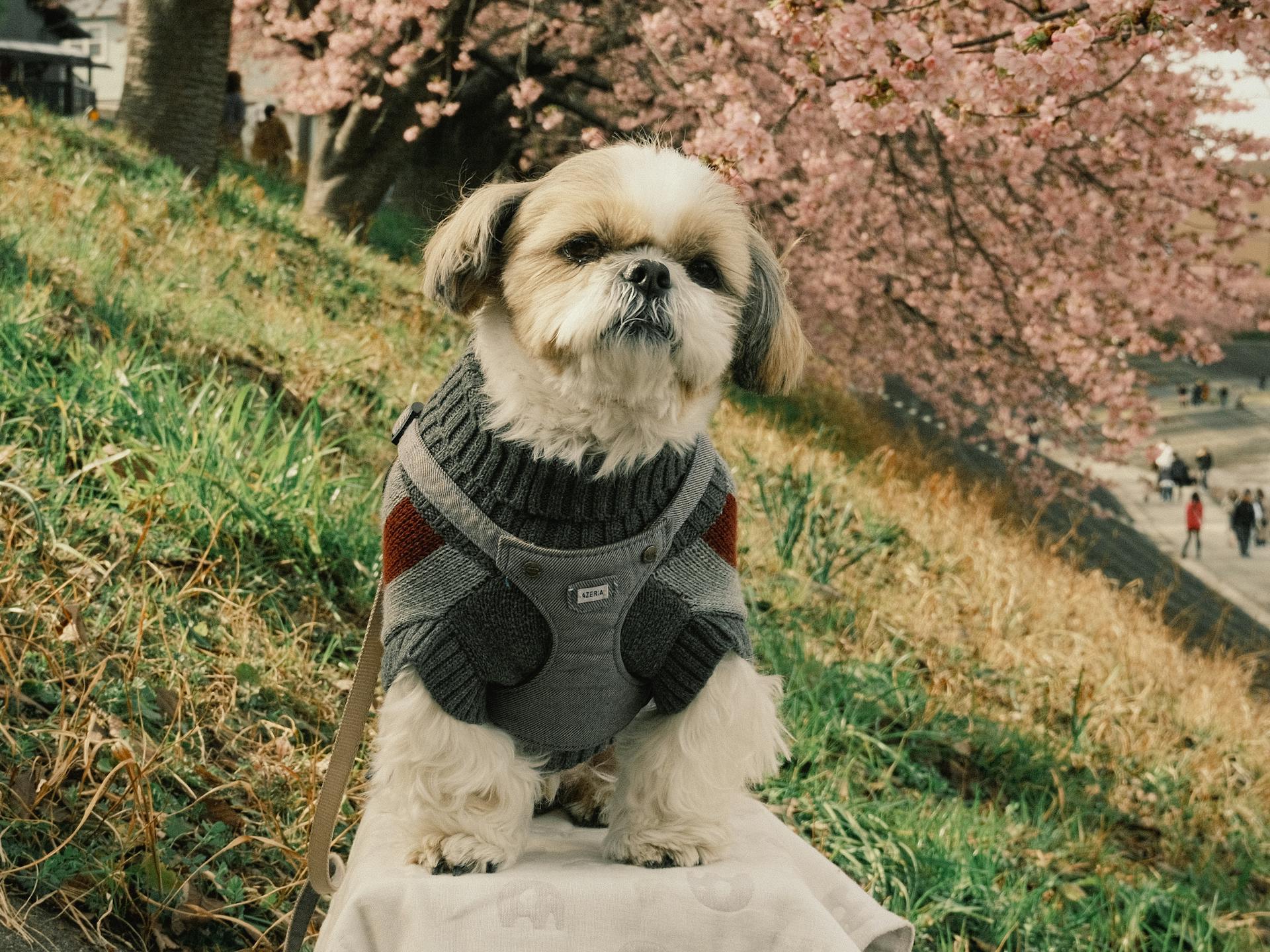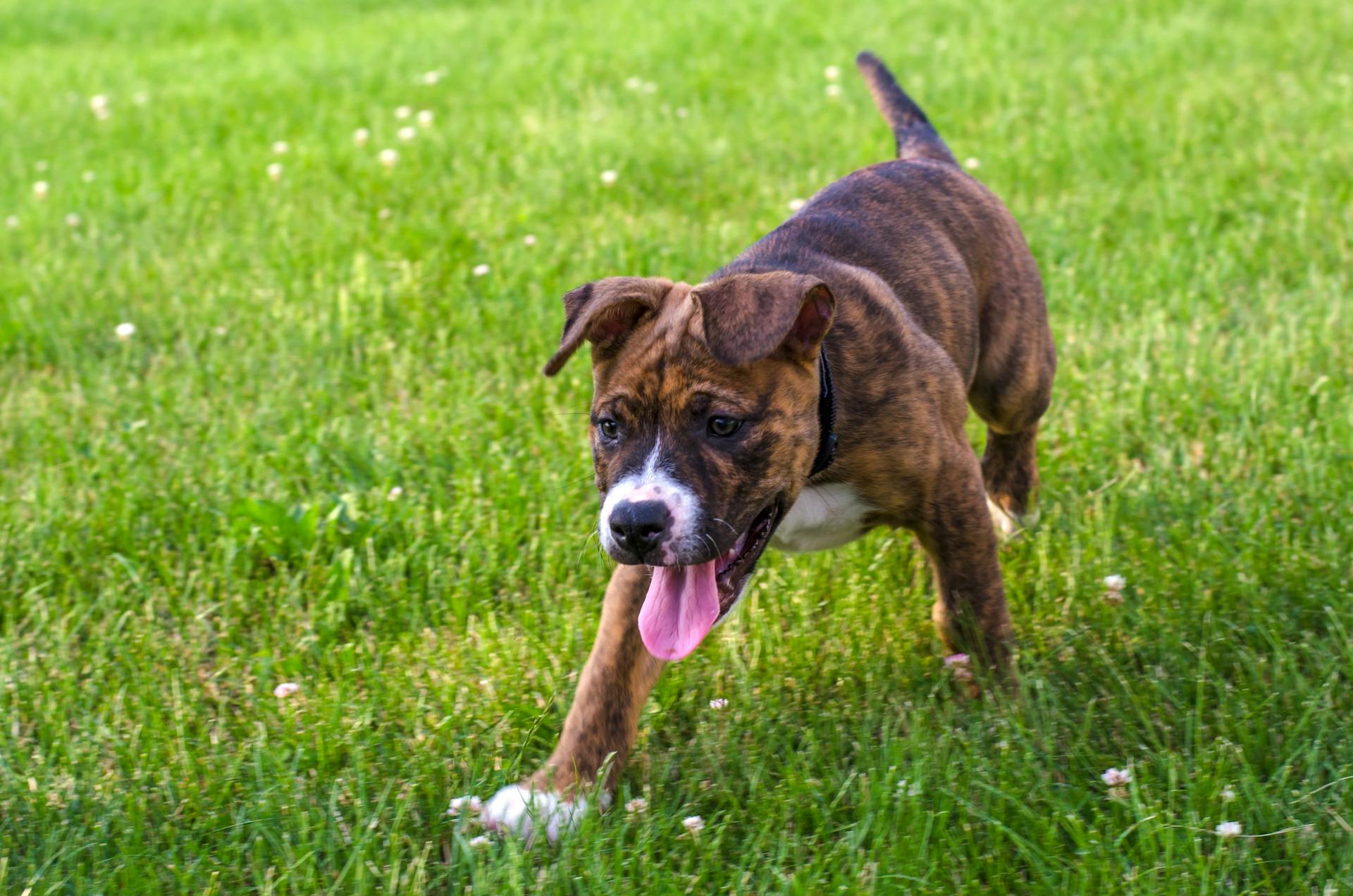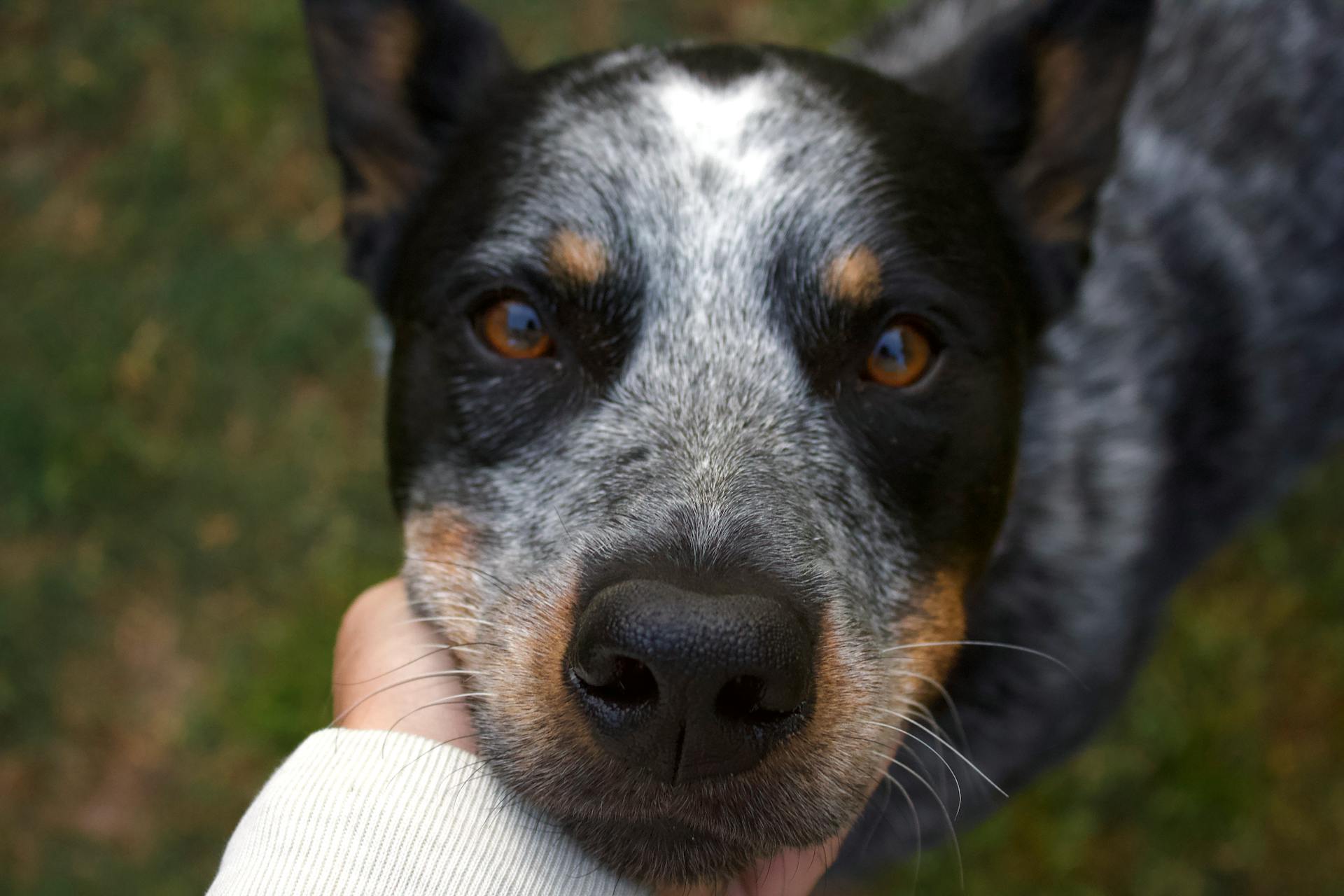
If you're considering bringing a Blue Heeler into your family, it's essential to understand their unique needs and characteristics. Blue Heelers are a high-energy breed that requires regular exercise to stay happy and healthy.
They are intelligent and trainable, but also strong-willed and independent. This means they need patient and consistent training from an early age.
Blue Heelers are naturally protective of their family and territory, making them excellent watchdogs. However, this also means they can be wary of strangers, so socialization is crucial from an early age.
Their short coats make them a low-maintenance breed in terms of grooming, but they still need regular nail trimming and ear cleaning.
You might enjoy: Blue Heeler as Family Dog
History of Blue Heelers
The Australian Cattle Dog, also known as the Blue Heeler, has a rich history dating back to the early 1800s.
Thomas Hall from New South Wales is credited with creating the first Blue Heelers by crossbreeding dogs that were being used as drovers in Northumberland with tamed dingoes.
In the 19th century, the settlers in Australia needed a dog that could guard and herd livestock in hot conditions, and could also withstand rough terrain and run for long distances.
The Blue Heeler was originally bred to herd livestock in Australia, and its high energy levels and stamina were desired to cope with the rough terrain and high temperatures of the Australian outback.
The Blue Heeler's nickname "Heeler" arose because of its tendency to nip at cattle's heels to encourage the direction of movement while herding.
Thomas Hall's original breed, the Halls Heeler, was crossed with other breeds such as Dalmatians, Bull Terriers, and Kelpies to create the Blue Heeler.
The Blue Heeler was first introduced to the United States in the 1940s and was registered by the American Kennel Club in 1980.
The Australian Cattle Dog Club of America is the official breed club in the US, and the Blue Heeler is also recognized by several other kennel clubs around the world.
Suggestion: Origin of Blue Heeler Cattle Dog
Physical Characteristics
The Blue Heeler is a medium-sized breed that's both strong and agile, making them perfect for their original job as drovers. They typically stand between 17 and 20 inches tall.
Males usually reach a height of 18-20 inches, while females reach a height of 17-19 inches. Their weight can range between 35 to 50lb for both males and females.
Their athletic build is due to their broad head, powerful jaw, and sloping shoulders. They have strong forelegs and muscular hind legs that help them move quickly and easily.
You'll often see their ears set apart on the top of their head, much like a German Shepherd's ears. Their tail can be docked if they're working dogs in the US, but in other countries like the UK and Australia, it's kept at its full length to help with maneuverability.
Here are the exact height and weight ranges for Blue Heelers:
Their coat is a double coat that's short in length and can be strong and stiff. They shed excessively two times a year, but they're relatively low maintenance dogs that don't require much grooming.
Health and Maintenance
Blue heelers require very little grooming, just a brush once every two to three weeks with a natural bristle brush.
They don't shed all year round, with males shedding once a year and females shedding twice a year, usually following their heat cycles.
Regular nail trimming is a must to prevent overgrowth, and their ears should be cleaned every few weeks to prevent infections.
A good wipe down with a damp cloth after a day of play or work is all they need, unless they get dirty from working with livestock, in which case a mild shampoo bath is in order.
For your interest: Blue Heeler Shedding Tips
Health Risks
Australian Cattle Dogs and Blue Heelers are generally healthy breeds, but they can be prone to certain health issues. Deafness is a common concern, especially in Australian Cattle Dogs with speckled markings in their coat.
Australian Cattle Dogs are also at risk of OCD, Progressive retinal atrophy, and hip dysplasia. These conditions can have a significant impact on your dog's quality of life.
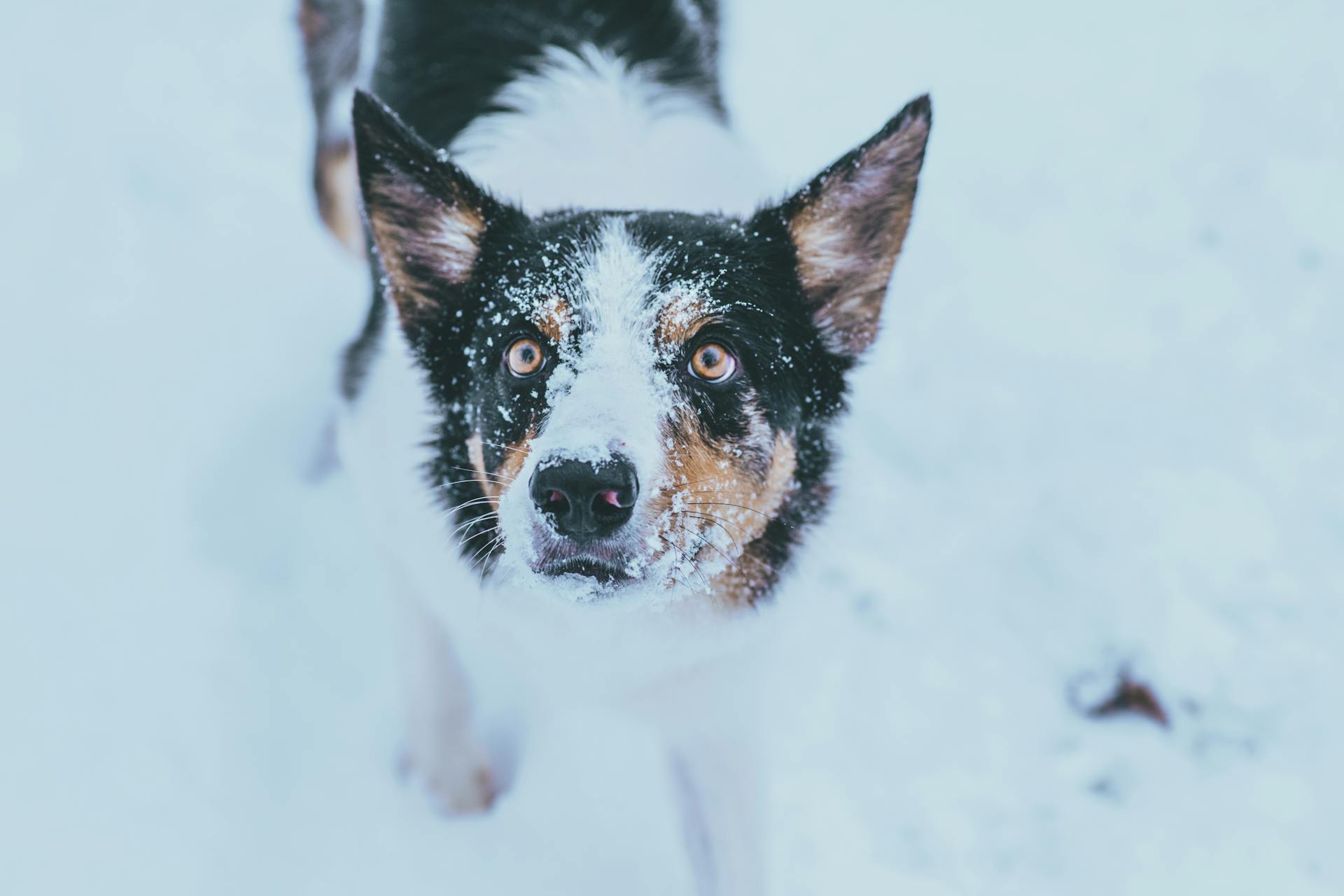
Progressive retinal atrophy is a series of conditions that cause eventual blindness, and it's incurable. This can be a challenging diagnosis for both you and your dog.
Hip dysplasia and elbow dysplasia are two conditions that are seen in other large dogs. They're caused by the incorrect formation of cartilage in the hip or elbow joint.
Here are some key health risks to be aware of:
- Deafness
- OCD
- Progressive retinal atrophy
- Hip dysplasia
- Elbow dysplasia
Maintenance
Grooming is a breeze for Australian Cattle Dogs, requiring only a brush every two to three weeks with a natural bristle brush.
They don't shed all year round, but when they do, it's usually after a heat cycle for females, and males shed once a year. During these times, they need a little more frequent brushing.
Australian Cattle Dogs are also relatively low maintenance when it comes to bathing. If they're still working with livestock, a bath with mild shampoo is necessary to remove mud, but otherwise, a simple wipe down with a damp cloth will do.
Their nails need regular trimming, and their ears should be cleaned every few weeks to prevent infections.
If you're looking for breeds with similar maintenance needs, consider the following options:
Best Diet
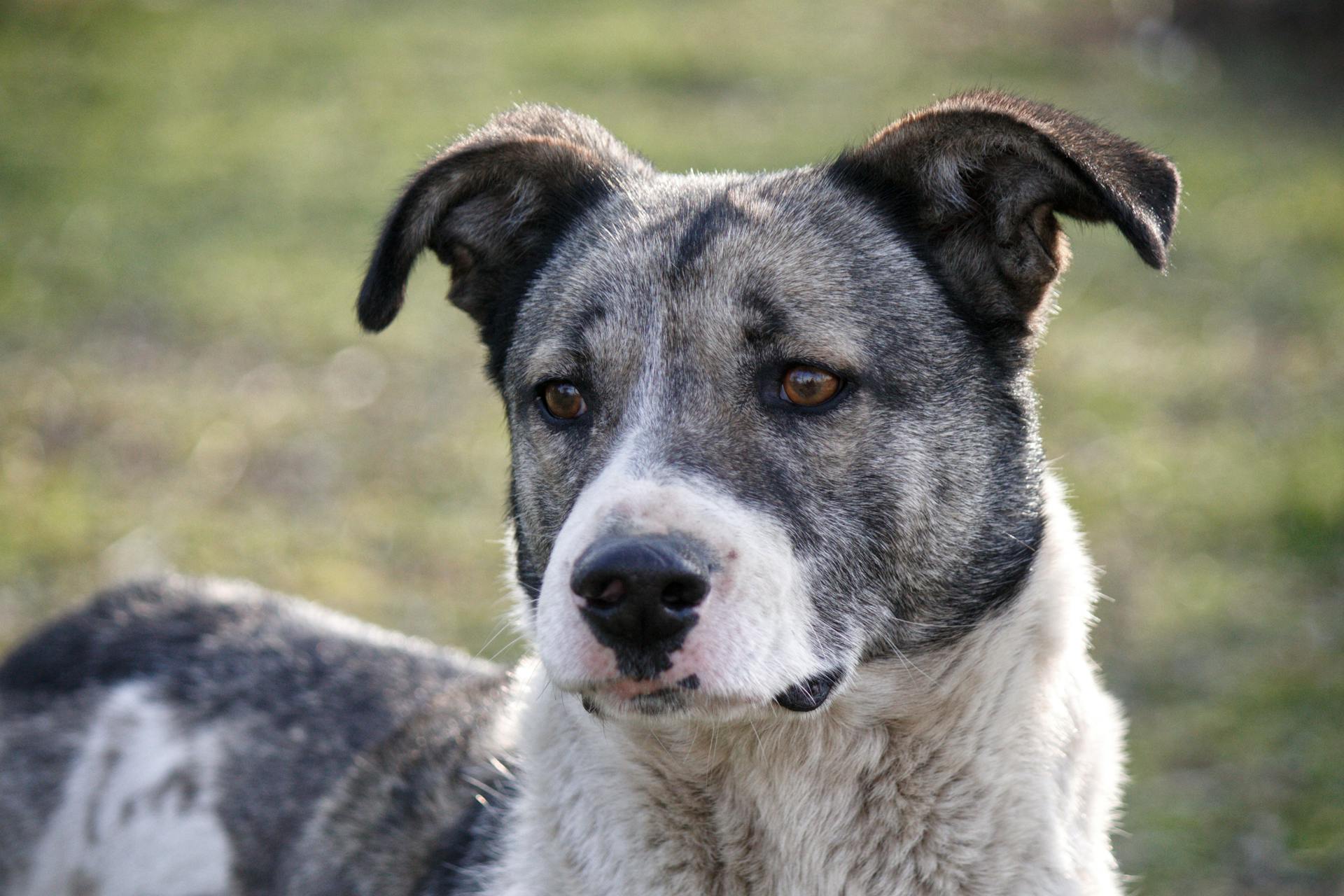
Australian Cattle Dogs are a very active breed, so they need a diet that provides enough nutrients and calories to support their energy level.
You should look for high-quality dog food that has protein as the main ingredient to keep your Australian Cattle Dog strong and healthy.
Feeding your Australian Cattle Dog a diet that's formulated specifically for working type dogs can help keep their joints healthy and in good condition.
Their diet should support their active lifestyle, so choose a food that's designed to meet their unique needs.
Australian Cattle Dogs require a balanced diet that includes protein as the main ingredient to keep them in top shape.
You might enjoy: Best Food for Blue Heeler
Lifespan
Blue Heelers are known for their longevity, with a relatively long life expectancy that can range from 12 to 15 years old.
Care and Upkeep
Blue Heelers are a high-energy breed that requires daily exercise, such as long hikes or jogs, coupled with vigorous games.
They excel in herding activities and can also participate in agility, obedience, tracking, and other dog sports.
To keep their coat in good condition, they only need occasional brushing to remove dead hairs, which are abundant during their two shedding seasons in fall and spring.
Their short double coat requires weekly brushing with a slick brush to remove any loose undercoat.
Regular nail clipping and brushing their teeth as frequently as possible can also help prevent health issues.
A high-quality dog food with protein as the main ingredient is essential to keep them strong and healthy, especially since they're prone to hip dysplasia.
Grooming
The Australian Cattle Dog's coat is thick but requires only occasional brushing to remove dead hairs. Australian Cattle Dogs are prone to hip dysplasia, and their coat shedding can be quite abundant during their two shedding seasons.
Brushing your Australian Cattle Dog once a week with a slick brush can help remove any loose undercoat. This is especially important during their shedding seasons.
They won't need to be bathed very often, unless they have rolled in something unpleasant. Regular brushing can also help prevent matting and tangling.
You'll also need to clip their nails every so often to keep them clean and healthy. Australian Cattle Dogs are prone to hip dysplasia, so it's essential to keep them at a healthy weight.
Brushing their teeth as frequently as you can is crucial to prevent build-up of decay that could lead to gum disease. You can also feed them dental sticks and crunchy kibble to help keep their teeth clean.
Best Food
Australian Cattle Dogs are a very active breed, so they need high-quality dog food with protein as the main ingredient to support their energy needs.
Their diet should be formulated specifically for working type dogs to keep their joints healthy and strong.
Look for dog food that's been designed to keep joints healthy, which will help prevent joint problems down the line.
You'll want to check out the best wet dog food and the best dry dog food options to find the perfect fit for your Australian Cattle Dog.
Frequently Asked Questions
Do Blue Heelers bond to one person?
Blue Heelers tend to form strong bonds with one person in their family, often becoming extremely loyal and attached to them. This unique bond is a characteristic of the breed, making them a beloved companion for many families.
Featured Images: pexels.com
